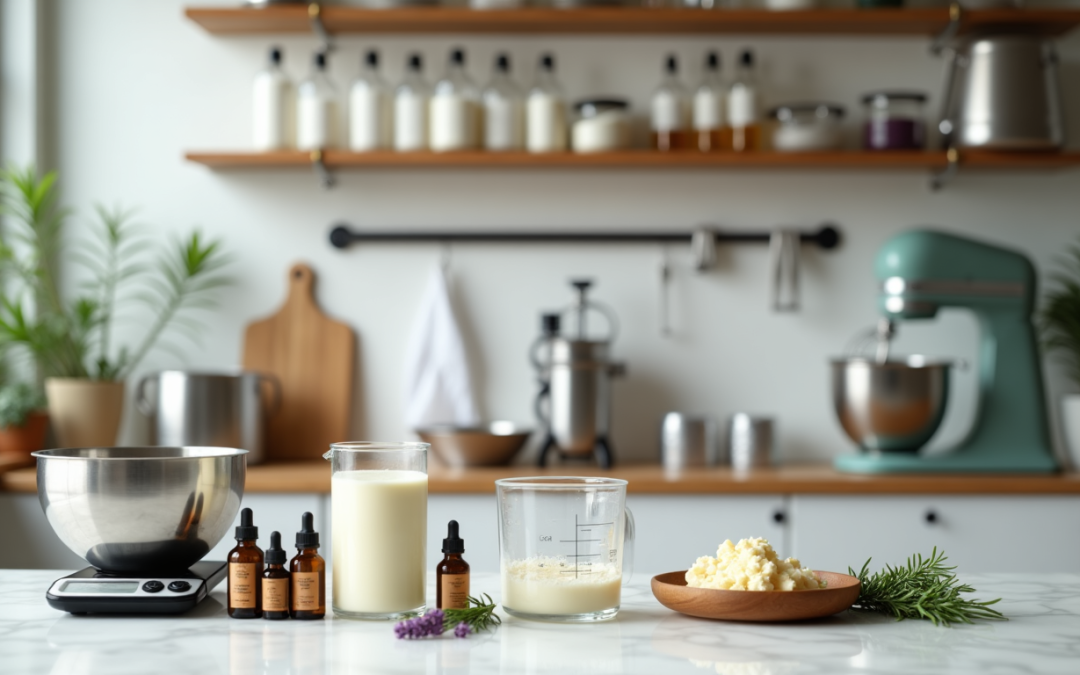The hair product industry will reach an impressive $93.74 billion in 2024. You don’t need millions to get your share of this profitable market. Starting your own hair care brand costs just 100,000.
The perfect time to enter this market is now. Beauty enthusiasts and future entrepreneurs can take advantage of current trends. Natural beauty products attract 56% of millennials and Gen X customers. The natural hair care market keeps growing steadily. New brands have plenty of opportunities to succeed. Private label products make up 25% of all unit sales in the US. This shows that new companies can thrive in cosmetic manufacturing.
Let’s help you turn your kitchen experiments into a successful hair care brand. This piece shows you how to pick the right equipment and create formulas. You’ll learn to scale production and move into commercial manufacturing. Your hair care brand vision can become real today.
Essential Equipment for Home Production
You need to carefully select your equipment when starting a hair care brand. The tools range from simple kitchen items to specialized manufacturing equipment. The right tools and safety requirements will build a strong foundation for your production experience.
Simple kitchen tools you already have
Your kitchen has many tools you can use, but these must be used only for cosmetic production. Using these tools for food preparation could contaminate your products. You’ll need stainless steel or silicone utensils because wooden tools are too porous and might harbor bacteria. Glass containers work well to produce small batches if you sanitize them by boiling for 10-15 minutes.
Small batch manufacturing equipment
Your production needs will grow, so you should invest in specialized cosmetic manufacturing equipment. A laboratory mixer costs between PKR 83,304 and PKR 1,943,772 and is the life-blood of small-batch production. These mixers come with high-energy stainless steel components and load cells that measure ingredients precisely.
Focus on mixing equipment instead of automated filling systems when you start. Manual filling and labeling are enough for small batches. Laboratory mixers give you these great advantages:
- Testing ingredient stability
- Market testing with small batches
- Producing consistent mixtures on a budget
Safety gear requirements
Personal Protective Equipment (PPE) is a vital part of maintaining product quality and keeping manufacturers safe. A detailed safety setup has:
- Basic Protection:
- Nonsterile disposable gloves
- Hair nets
- Closed-toe shoes
- Eye protection
- Workspace Requirements:
- Sanitized work area
- Clean utensils and measuring tools
- Properly sanitized containers
Your sanitization protocols should use non-toxic cleaners, especially because water-based products create environments where bacteria thrive. Make sure all containers are completely dry before use. Heat your oven to 280 degrees Fahrenheit and place glass containers inside for about 10 minutes to dry them fully.
Creating Your First Formula
Creating your first hair care product requires you to know how ingredients work together and affect different hair types. A methodical process will give you a quality product that delivers results.
Choosing ingredients wisely
Natural ingredients with specific functions make the best starting point. Starch works well to smooth hair cuticles and boost strand appearance. To cite an instance, corn starch provides both volumizing and cleansing benefits, while rice starch helps hair growth and strengthens roots.
Organic acids benefit hair of all types. Citric acid makes hair smoother and glossier, while lactic acid keeps pH balanced and seals hair cuticles. Malic acid helps produce collagen, which strengthens hair from root to tip.
Multifunctional ingredients that deliver several benefits at once deserve your attention. These elements hydrate, smooth, and sanitize hair while meeting safety standards. The best results come from ingredients that keep the scalp’s natural pH and support a healthy microbiome.
Testing methods at home
Small batch testing helps assess how well your product works. You can check cleansing power by testing 12.5cm long hair tresses and measuring how much lipid they remove.
Conditioner testing needs six 0.5-gram swatches of blonde or white hair. A dye absorption test on these treated swatches shows how well ingredients penetrate. Gravimetric analysis verifies moisturizing claims through moisture content testing.
Product stability needs monitoring under different conditions to ensure consistent results. Your formulations should undergo temperature testing to track changes in texture, color, and scent. Note that precise measurements are vital – weighing ingredients in grams works better than volume measurements. This precision helps you reproduce results and maintain quality across batches.
Setting Up Your Production Space
Turning your home into a cosmetic manufacturing hub needs smart planning and gradual growth. A well-laid-out production space will give a solid foundation for quality products and streamlined processes.
Kitchen organization basics
Your first step is to set aside a dedicated area just for product creation. Tool organization becomes easier with utensil caddies that keep everything available. The next step is to create separate zones for storing ingredients, mixing, and packaging. Your sanitization protocols must be strict – non-toxic cleaners work best, especially with water-based products that could attract bacteria.
A lab journal system helps you track all experiments and production batches effectively. This method documents successful formulations and helps maintain quality standards. Glass beakers of different sizes protect your ingredients from contamination and let you measure precisely.
Scaling to garage manufacturing
Your growing orders might need a garage or spare room setup. Many successful entrepreneurs have turned these spaces into working cosmetic labs. The best approach is to start with small batches – most startups can handle around 100 units per production cycle.
Your garage facility must follow Good Manufacturing Practice (GMP) guidelines to maintain safety and consistency. Proper ventilation systems and temperature controls protect your ingredient quality. Industrial shelving units help organize the space, with costs ranging between PKR 1,388,408 and PKR 4,165,225.
Equipment upgrades under small budget
Essential upgrades can boost efficiency without breaking your budget. A digital scale and professional-grade blender form the foundation of your equipment. A stick blender works great for smaller batches and costs less than expensive homogenizers.
Laboratory-grade beakers and pH testing equipment ensure precise measurements. These tools maintain product quality and stability consistently. Note that successful manufacturing doesn’t need expensive equipment at first – the right tools that ensure accuracy and safety will help maintain product standards.
Moving to Commercial Manufacturing
Making a choice between in-house production and contract manufacturing is a vital milestone as you scale your hair care brand. The right timing and cost evaluation will give a smooth transition to commercial manufacturing.
When to make the switch
The best time to move to commercial manufacturing comes when your weekly revenue hits PKR 416,522 to PKR 555,363. Outsourcing becomes budget-friendly at this point since manufacturers can optimize processes to minimize waste and maximize output. Watch for signs like consistent six-week advance bookings or struggles to meet orders with your current setup.
Finding reliable manufacturers
The right manufacturers should match your needs based on their expertise and quality standards. They should provide:
- Complete control over manufacturing processes
- Flexibility in production schedules
- Access to specialized knowledge and technologies
Take a close look at their Good Manufacturing Practices (GMP) compliance, especially ISO22716:2007 certification for cosmetic products. A good manufacturer should give you:
- Detailed test reports for stability and safety
- Performance testing documentation
- Quality control systems that cover everything
Cost comparisons
The original investment for commercial manufacturing ranges between PKR 799,445 and PKR 12,918,586. Outsourcing can cut costs by 30-50% compared to making products in-house. Contract manufacturers help you save through:
- Lower upfront capital needs
- Less facility maintenance
- Production economies of scale
Private label manufacturing stands out as another solid option that gives you exclusive rights to sell specific products. This path lets brands reduce costs through bulk order discounts and quick supply chain management. Look for manufacturers offering expandable solutions that grow with you without affecting product quality.
Conclusion
A hair care brand’s success needs careful planning, proper equipment and a systematic approach to growth. Your experience from kitchen experiments to commercial success depends on smart decisions at every growth stage.
You can test and refine formulas while keeping risks low through small-batch production. Quality products that meet market needs come from organized workspaces and proper safety protocols. Your brand’s growth will require equipment upgrades, though budget control remains crucial to green scaling.
Commercial manufacturing represents the most important milestone. When weekly revenue hits PKR 416,522, manufacturer partnerships can lower costs while product quality stays high. This change lets you concentrate on brand growth instead of production issues.
Note that the hair care industry rewards consistent quality, complete testing and strict manufacturing standards. Many successful brands began just like you – with simple kitchen tools and a clear vision. Natural hair care products and the growing private label market make the path from kitchen creator to successful brand owner achievable.
Your hair care brand can thrive with careful planning and systematic execution. Every step builds toward establishing your brand in the billion-dollar hair care market, from choosing original equipment to scaling production.
FAQs
Q1. How much does it typically cost to start a hair care brand?
The initial investment for launching a hair care brand can range from approximately PKR 0.1 million to PKR 13.9 million, depending on factors such as production scale, equipment, and marketing strategies.
Q2. What essential equipment do I need to start producing hair care products at home?
To begin, you’ll need basic kitchen tools dedicated to cosmetic production, such as stainless steel or silicone utensils, glass containers, and a digital scale. As you scale up, consider investing in a laboratory mixer and small batch manufacturing equipment.
Q3. How do I create and test my first hair care formula?
Start by choosing natural ingredients that serve specific functions for hair health. Create small batches and conduct tests for cleansing efficiency, conditioning effectiveness, and moisture content. Always use precise measurements and document your experiments in a lab journal.
Q4. When should I transition from home production to commercial manufacturing?
Consider moving to commercial manufacturing when your weekly revenue reaches between PKR 416,522 to PKR 555,363. This transition becomes cost-effective when you can no longer meet demand with your current setup or have consistent six-week advance bookings.
Q5. How can I ensure the safety and quality of my hair care products?
Implement strict sanitization protocols, use proper safety gear, and conduct thorough testing for stability and effectiveness. When scaling up, prioritize manufacturers with Good Manufacturing Practices (GMP) compliance, particularly ISO22716:2007 certification for cosmetic products.

